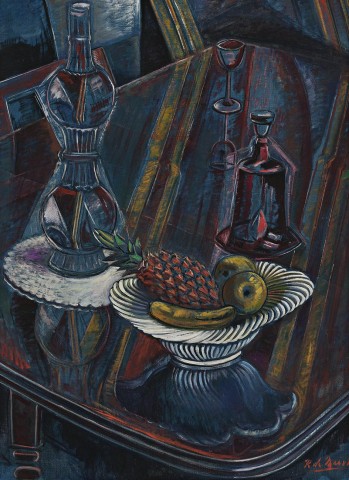STILL LIFE, BOTTLE AND FRUIT, c.1955
ROY DE MAISTRE
oil on canvas
97.0 x 71.0 cm
signed lower right: R de Maistre
bears inscription on old label verso: STILL LIFE WITH LAMP / oil / R de Maistre / 13 Eccleston Street / London SWI
Estate of the artist, London
Magda Joicey, London
Thence by descent
Private collection, Melbourne
Deutscher and Hackett, Melbourne, 27 August 2008, lot 29 (as ‘Still Life with Bottle and Fruit’)
Private collection, Melbourne
We are grateful to Heather Johnson for her his assistance in cataloguing this work
Roy de Maistre was, above all, a scientific painter who approached his subjects with studious precision and analysis. He would paint numerous preliminary studies of his compositions and once finalised, would then execute a further series of variations. Whilst the studies were the arena in which he allowed for experimentation, the final works are so harmoniously composed that there is never a mark out of place. Characteristic of this approach is Still Life, Bottle and Fruit, c.1955 which depicts a small corner of de Maistre’s London studio at 13 Eccleston Street, a fantastically arranged and decorated haven described by the artist’s biographer Heather Johnson as being ‘(o)ne of de Maistre's greatest works of art, and the one most appreciated by friends, relatives, and acquaintances’.1
An early pioneer of modernism in Australia, de Maistre subsequently studied under the tonalist Max Meldrum before expanding his talents into the arenas of interior decoration, furniture design and art direction for photography. Frustrated by the limitations of conservative Sydney, he relocated to London in 1930 and, within months, was exhibiting at the premier avant-garde Beaux Arts Gallery and participated in a three-person show which included the twenty year old Francis Bacon, who was to become de Maistre’s protégé for the next seven years. In 1937, through the aegis of his close friend and patroness Sydney Courtauld, de Maistre moved into the Eccleston Street studio where he lived until his death. The years prior had seen him investigate a further variety of painting strategies but the foundations for his mature style were firmly in place by the late 1930s. This was a form of analytical (as opposed to synthetic) Cubism but one where the ‘depiction of the relationship between objects and space … stems more directly from Cézanne than from Picasso and Braque’.2 This same aesthetic underpins the richly detailed and coloured Still Life, Bottle and Fruit.
In a manner similar to the Italian Giorgio Morandi, de Maistre was a studio-based artist who never had to look far for subject matter. ‘The result is that he looks with fascinated intensity about the ... studio ... and this scrutiny, searching yet affectionate, has made him a kind of intimiste. Each object of contemplation (has) been combined in lucid, close-knit arrangements expressive of the painter’s relation to his surroundings’.3 In Still Life, Bottle and Fruit, de Maistre has orchestrated the reflections within the glassware and the polished surface of the table into an absorbing composition full of angles, directional line and, above all, colour.4 Having developed a personal colour-music chart which he kept secured at the top of his box-palette,5 de Maistre famously claimed he could ‘whistle the tune’ of his paintings; and comparison with one of those charts suggests this painting may have been composed in the keys of E♭ (green-blue) through to G♭ (indigo-violet). Curiously, the painting also exhibits de Maistre’s awareness of other contemporaneous artists in elements such as the striking pineapple and its companion fruits which look like émigrés from a Max Beckmann painting. Rigorous, ordered and above all, highly personalised, Still Life, Bottle and Fruit, is an excellent example of the artist’s mature vision.
1. Johnson, H., Roy de Maistre: the English years 1930 – 1968, Craftsman House, Sydney, 1995, p. 48
2. McClean, I., ‘Two Modern Artists’, Art Notes, London, Summer, 1946, quoted in Johnson, H., op cit, p. 138
3. Rothenstein, J., ‘Introduction’, Roy de Maistre: A Retrospective. Exhibition of Paintings from 1917-1960, Whitechapel Art Gallery, London, May 1960, p. 9
4. The unusual double-sphered bottle also appears in Studio Interior (n.d.), reproduced in Johnson, H., op cit., pl. 21.
5. As depicted in Studio – 13 Eccleston Street (after 1937), Collection: Art Gallery of New South Wales.
ANDREW GAYNOR
